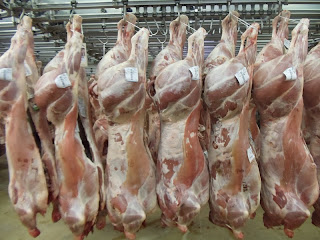When the sun goes down in Marrakech, dozens of food stalls pop up in the main square, Djemaa el Fna. In order to take full advantage of the gastronomical magnificence that this place has to offer, we visited the stalls and had delicious meals. However, I wanted to learn how to make these dishes myself, so I took a class with chef Fouzia Habrich, cuisine chef at Dar les Cigognes, a riad turned boutique hotel in Marrakech.
 |
| rooftop terrace for dinner at dar les cigognes, marrakech |
Many foreigners have purchased large townhouses in the Marrakech and Fez medinas and turned them into boutique hotels. This one in particular is gorgeous and the service is incomparable to any hotel I've ever stayed. The staff were doting on our son, offering us delicious mint tea at all hours of the day, helping us arrange the day's tourism adventures, and serving us wonderful food.
My morning with the riad's chef began with a food market tour, where he introduced me to Moroccan spices and ingredients.
He taught me how to make tagine and couscous, the real mccoy. When Moroccans say they will make "tagine" for dinner, they are not talking about the receptacle in which it is made, which also has this name. They are talking about the dish, which includes at least seven vegetables and a protein, either chicken, lamb, beef, etc. I will share his recipe for chicken tagine with you.
 |
| tagine |
*If using a tagine, this dish will take 3-4 hours. Chef used a pressure cooker to quicken the process, but I believe it is safer to use a slow cooker or a tagine.
Ingredients:
parsley
cilantro
red onion
2 garlic cloves
pepper
ground ginger
paprika
saffron
cumin
salt
lemon confit **
olive oil
chicken breast and/or thighs
red olives
In a pressure cooker, sweat finely chopped red onion, add garlic cloves and sweat. Season with salt and pepper. Add chicken and saute for about 15 minutes at low heat. Add chopped parsley, cilantro, paprika, ground ginger, saffron, cumin, and lemon confit and a bit of water and close the pressure cooker and let cook for about 30 minutes. Add red olives and close the pressure cooker for a final 20 minutes.
**Lemon confit is a new ingredient for me. It is used widely in Moroccan cuisine, and I saw it everywhere in the markets. It gives these dishes an interesting citrus/salty flavor, and I was told no tagine is complete without it. Here's the recipe for lemon confit:
Sterilize a glass jar and fill with water, salt, and whole lemons. Close jar and keep for 4-6 months.
 |
| lemon confit |
 |
| chicken tajine with lemon confit and red olives |
Next Moroccan blog entry: couscous.


































